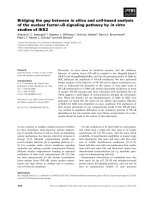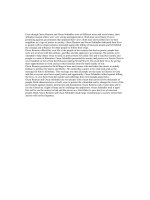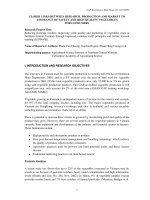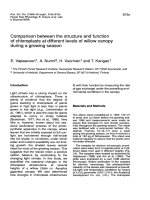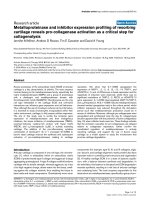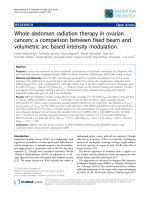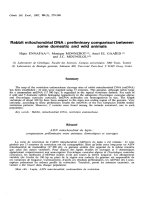Comparison between LowProgrammable Freezing and Fast Freezing Protocols of Hungarian Guinea Fowl Seme
Bạn đang xem bản rút gọn của tài liệu. Xem và tải ngay bản đầy đủ của tài liệu tại đây (475.3 KB, 10 trang )
Athens Journal of Natural & Formal Sciences
September 2014
Comparison between Low/Programmable
Freezing and Fast Freezing Protocols of
Hungarian Guinea Fowl Semen
By Thieu Ngoc Lan Phuong
Eva Varadi†
Barbara Vegi‡
Krisztina Liptoi
Judit Barna•
Semen cryopreservation is a practical method for banking
germplasm from valuable indigenous species which have an
increasing risk of extinction. Many scientific publications have
described different protocols of avian sperm cryopreservation for
both domesticated and non-domesticated avian species, involving
cryoprotectant type and packaging method, as well as freezing and
thawing rates. In this research, a comparative approach was used to
evaluate two freezing protocols for guinea fowls: the modified slow
programmable method using 10% ethylene glycol (EG), and the
newly applied fast freezing method (pellet formation) with 6%
dimethylacetamide (DMA). The efficiency of two protocols is
measured by both in vitro sperm evaluation assay (determination of
sperm concentration and motility, morphological and live/dead
sperm analysis) and in vivo sperm evaluation assay (artificial
insemination, determination of fertility rate and embryonic death).
For fertility determination, candling of incubated eggs was used,
extended by checking of the ratio of early embryonic mortality. In
vitro qualification showed that the survival rate of live and intact
spermatozoa was significantly higher after pelletation than after
slow protocol (28.59% vs 23.53%, p=0.022, Mann-Whitney U test).
In vivo qualification showed that artificial insemination of frozenthawed semen yielded 50.2% fertility rate with the pellet, while only
25.5% with the slow programmable method (while it was 84.8% in
control, p=0.027, Kruskal-Wallis ANOVA test). The simple in vitro
DVM, MSc, Research Centre for Farm Animal Gene Conservation (HáGK), Hungary.
MSc, Fellow Researcher, Research Centre for Farm Animal Gene Conservation (HáGK),
Hungary.
‡
PhD, Fellow Researcher, Research Centre for Farm Animal Gene Conservation (HáGK),
Hungary.
PhD, Senior Researcher, Research Centre for Farm Animal Gene Conservation (HáGK),
Hungary.
•
DVM, PhD, Research Centre for Farm Animal Gene Conservation (HáGK), Hungary.
†
175
Vol. 1, No. 3
Phuong et al.: Comparison between Low/Programmable Freezing...
examinations used in this research were not able to detect injuries
which caused embryonic death during freezing procedure, therefore,
despite the seemingly acceptable sperm surviving rate, the ratio of
eggs containing a normal embryo in case of slow, programmable
frozen-thawed semen artificial insemination was significantly lower
than in case of fresh semen artificial insemination (5.88% and
70.46%, while it was 28.37% in case of pellets, p=0.038, Kruskal
Wallis ANOVA test).
Introduction
Frozen storage of avian semen has been established for approximately
more than 60 years (POLGE, 1951). Since the freezing tolerance of
spermatozoa is the lowest among poultry species, due to their characteristic
structure of sperm membrane (BLESBOIS et al., 2005), only domestic birds
such as chicken, turkey, goose spermatozoa have been successfully frozen
(DONOGHUE and WISHART, 2000). There are various methods available for
avian cryopreservation such as vitrification in pellet form, rotation method, or
slow, programmable freezing. Vitrification means the production of an
amorphous state without any crystallization, defined by the viscosity. The
amorphous state is like a "solid-liquid". The transformation is over a small
temperature range described as the glass transition temperature. In simplified
terms, it can be described as solidification of a liquid into an amorphous state
while maintaining the same molecular orientations that existed in solution
before the glass transition. The semen is frozen by rapid cooling through direct
plunging of semen droplets into liquid nitrogen to form frozen pellets. The
procedure takes a few seconds for cooling so removal of cryoprotectant before
artificial insemination is not required. There were several modified pellet
formations which have been described so far. In the study of Tereda, 0.2 ml
volumes of semen were dropped onto a depression in solid CO2, then,
transferred into liquid nitrogen (TEREDA et al., 1989). In another study,
Tsuletin dropped 0.2 ml volumes of semen onto fluoro-plastic plate held in
liquid nitrogen vapour at -70oC, then transferred into liquid nitrogen
(TSELUTIN et al, 1995). And, recently, in the study of Iaffaldano, 60 µm and
80 µm volumes of semen were plunged into liquid nitrogen after equilibrating
at 4oC for 1 to 5 minutes (IAFFALDANO et al., 2011). In the rotation method
described by Kurbatov (1984), 1 ml of samples within a 10 ml capacity glass
was rotated in liquid nitrogen vapour at -70oC before plunging into liquid
nitrogen. Contrary to these fast freezing methods, the slow freezing method
using programmable freezers has been described by Lake in 1984, Wishart,
Seigneurin and Blesbois in 1995. The samples within glass ampoules or plastic
cryovials or straws are cooled from 5oC to -35oC at between 1 to 10oC/min
before plunging into liquid nitrogen. Thawing systems involve placing the
plunging samples from -196oC into thermal bath or in a thermo-regulated
hotplate adjusted to 60oC to 75oC. There were a few studies that described the
sperm freezing of guinea fowl so far (SEIGNEURIN and BLESBOIS, 2005;
176
Athens Journal of Natural & Formal Sciences
September 2014
VÁRADI et al., 2013). In Hungary, successful application of semen freezing
technology in guinea fowl has been carried out at the Research Centre for Farm
Animal Gene Conservation (HáGK). Thus, this paper aims to describe in detail
the fast and slow freezing of guinea fowl spermatozoa, and to compare these
two protocols by using both in vitro and in vivo sperm evaluation assay.
Materials and Methods
30 one-year old Hungarian landrace guinea fowl males and 30 guinea fowl
females originated from HáGK gene bank (SZALAY et al., 2009) were used as
sperm donors and sperm receivers. The semen was collected by a non-invasive
method, the dorso-abdominal massage technique, adapted from chicken semen
collecting method (BURROWS AND QUINN, 1937) individually. A twoweek training of guinea cocks was carried out prior to the 8-week semen
collection program.
Slow, Programmable Protocol
After collecting, pooled semen was diluted 1:3 with Lake’s extender
(LAKE, 1986) at room temperature. Then, 10% ethylene glycol (EG) was
added into the diluted semen. 200 µl from the samples were measured and put
into cryovials. These cryovials were placed into the programmable freezing
machine (Planer KRYO10). Cooling was started from 20°C with freezing rate 3°C/min. 25 minutes of equilibration time followed when the temperature
reached 3°C. Then, freezing rate -1°C/min was applied to cool the cryovials
down to -30°C, and later freezing rate -30°C/min from -30oC to -60°C. Finally,
cryovials were removed from the freezing machine and plunged into liquid
nitrogen. Composition of Lake’s extender is demonstrated in table 3.
Vitrification in pellet form
After collecting, pooled semen was diluted 1:1 with Tselutin’s extender
(TSELUTIN et al, 1995) at room temperature. Then, the diluted semen was
equilibrated for 20 minutes at 2°C and treated with cryoprotectant dimethylacetamide (DMA) 6%. Treated semen was directly dropped into the liquid
nitrogen (25 µl / pellet) with a pipette. The pellets were collected into cryovials
and stored in liquid nitrogen.
Two freezing protocols used in this study were described in Table 1.
Table 1. Freezing Protocols
Protocol
Type of cryocontainer
Diluents
Dilution rate
Equilibration time
Freezing rate
CPs
Slow, programmable
Cryovial (200 µL)
Lake ‘s diluent (1986)
1:3
25 mins at 3 °C
-1oC/min until -30oC
-30oC/min until -60oC
10% EG
177
Pellet formation
Pellet (25 µL)
Tselutin’s diluent (1995)
1:1
20 mins at 2°C
Dropped directly into
liquid nitrogen
6% DMA
Vol. 1, No. 3
Phuong et al.: Comparison between Low/Programmable Freezing...
The samples frozen by slow, programmable method were thawed in a
cooling cabin at 5°C. The samples frozen by pellet method were thawed in an
automatic machine at 70°C.
The in vitro evaluation assay was carried out before freezing and after
thawing on each occasion except for the motility and concentration parameter.
Motility was examined only before freezing by subjective scoring from 0 to 5
based on the percentage of motile sperms and direction of sperm movement.
- Score 0: indicates no motility
- Score 1: indicates non-progressive motility (5-20% of
spermatozoa move)
- Score 2: indicates slow, progressive motility (20%-40% of
spermatozoa move)
- Score 3: indicates side to side movement accompanied by slow,
progressive motility (50% -70% of spermatozoa move)
- Score 4: indicates fast progressive motility (75%-85% of
spermatozoa move)
- Score 5: indicates very fast progressive motility (85%-95% of
spermatozoa move)
- Sperm concentration was measured by spectrophotometer
(Accucell IMV, France) in million/µl unit.
Morphological abnormalities and live/dead spermatozoa ratio of both fresh
semen and frozen-thawed semen were determined by aniline blue-eosin
staining.
For in vivo evaluation, 30 guinea hens were divided into 3 groups of 10
animals. Ten hens, used as controls, were inseminated with fresh semen twofold diluted in Lake’s extender while the remaining guinea hens were
inseminated with frozen-thawed semen, 10 hens with frozen-thawed semen
produced by slow, programmable freezing and the other 10 hens by fast
freezing in pellet form.
Artificial insemination was made 8 times per group totally, for 3 weeks,
with an average frequency of 2 times/ week and an average inseminating dose
of 290 ± 52 million spermatozoa/hen.
The collection of eggs started 2 days after the first insemination. Then, the
eggs were incubated by an incubator and the fertility was checked by candling
on day 7 or day 10 of incubation.
The germinal discs of eggs without an embryo were checked further by
staining with PI. The eggs with embryonic death in the oviduct showed a
stained nucleus under fluorescence microscope while the infertile eggs without
a nucleus showed dark-red background without lighting points.
For statistical analysis, the Mann-Whitney U test and Kruskal Wallis
ANOVA test of STATISTICA version 10 were used (STATSOFT INC., 2011)
178
Athens Journal of Natural & Formal Sciences
September 2014
Results
Results on in Vitro Evaluation
The motility, concentration and morphological abnormalities of fresh
semen collected for two freezing protocols are not significantly different
(p>0.05). The quality of frozen-thawed semen produced from slow,
programmable freezing and fast freezing in pellet form was shown in Figure 1.
After freezing and thawing, a significantly higher percentage of dead
spermatozoa was detected in the fast freezing (68.63%, p<0.001). Interestingly,
compared with fast freezing protocol, the slow, programmable freezing
produced a significantly lower percentage of live, intact spermatozoa (17.99%
vs. 21.35%, p=0.030).
Figure 1. Comparison of Quality of Frozen-thawed Semen produced from
Slow, Programmable Freezing and Fast Freezing in Pellet Form.
Results on in Vivo Evaluation
Fertility and embryo mortality in the three experimental groups following
the artificial inseminations was shown in Figure 2. Artificial insemination with
fresh semen yielded 84.8%, while slow freezing and fast freezing protocol
yielded 25.5% and 50.2% fertility rates, respectively. The percentage of
infertile eggs in the case of insemination with frozen-thawed semen in pellet
form was lower than in the case of insemination with slow, programmable
frozen-thawed semen (49.8% vs. 75.5%). The percentage of eggs with very
early embryonic deaths in the oviduct were very high in the slow,
programmable freezing group during the whole experimental period (week
1:18.42%, week 2: 34.29%, week 3: 23.53%) while in the pellet freezing and
control group, a decreasing tendency was observed (from 28.1% and 6.98% in
the 1st week to 4.5% and to 0% in 3rd week). Moreover, the percentage of eggs
containing normal development in the slow, programmable group was
179
Vol. 1, No. 3
Phuong et al.: Comparison between Low/Programmable Freezing...
extremely low compared with the pellet and control group (5.88% vs. 28.37%
vs. 70.46%, p=0.038).
Figure 2. Fertility and Embryo Mortality in the three Experimental Groups
Following the Artificial Inseminations
180
Athens Journal of Natural & Formal Sciences
September 2014
Discussion
In the present study, fresh semen of guinea fowls was successfully
collected by the adapted dorso-abdominal massage technique from the chicken
semen collecting method, and successfully frozen by both slow, programmable
protocol with 10% EG and vitrification in pellet form with DMA 6%. They
produced an acceptable average sperm survival rate of live and intact
spermatozoa (23.53% and 28.59%). The highest sperm survival rate of live and
intact spermatozoa, achieved in this study was 44.2% in case of the slow
freezing and 36.49% in the pellet method. This result was absolutely lower
than the highest sperm survival rate in previous study (higher than 60%). A
significantly higher percentage of live, abnormal spermatozoa was produced by
slow, programmable freezing than that produced by vitrification (23.06% vs.
10.02%, p<0.001). However, the number of dead spermatozoa in pellet form
was significantly higher than freezing by slow, programmable protocols
(68.63% vs. 58.96%, p<0.001). Although the live, abnormal spermatozoa are
able to fertilize after AI (VÉGI et al., 2005), the high rate of early embryonic
death (a mean of 25.41%) was observed in week 1 (18.42%), 2 (34.29%) and 3
(23.53%) while in the case of the pellet group, a high rate of early embryonic
death was observed only in the first week (28.13%), then it dropped
dramatically in the second week (2.7%) and third week (4.5%). This
observation showed that the percentage of live, abnormal spermatozoa in
frozen-thawed semen might give an effective estimate of eggs with embryonic
death produced after AI. Even though, not only in-vitro but also in vivo tests
were required for reliable testing of the effectiveness of freezing protocols
applied in guinea fowl because the simple in-vitro examinations used in this
study were not able to detect injuries such as DNA damage of spermatozoa
during the freezing and thawing process. The in-vitro tests were necessary to
predict the survival rate of spermatozoa and fertility rate in general and the invivo tests were inevitable to demonstrate the true quality of frozen-thawed
guinea fowl semen. According to fertility results of the slow protocol, 75.5% of
eggs were infertile, despite the seemingly acceptable sperm survival rate.
Contrary to the slow freezing protocol, frozen-thawed semen produced by the
pellet method produced 50.2% fertility rate after AI. Fertility rates of both
slow, programmable and the pellet group achieved in this study were higher
than the mean fertility rate obtained in the first study (20%). Apart from the
quality of AI semen expressed by the number of intact, viable spermatozoa
remaining in post-thawing semen, it was observed that the increase of number
of spermatozoa stored in the guinea hens oviduct by the 3rd weeks of AI, might
be important in determining the fertility rate. The choice of cryoprotectant
might be another factor that affected the fertilizing ability of frozen-thawed
spermatozoa. Since, the fertility rates, 0% for EG and 8% for DMA, were
reported in the first study, and 25.5% for EG, 50.2% for DMA, the
cryoprotectant DMA seemed to be less deleterious to sperm cells than EG.
181
Vol. 1, No. 3
Phuong et al.: Comparison between Low/Programmable Freezing...
Conclusion
In this study, vitrification in pellet form with Tselutin extender and
cryoprotectant DMA 6% was proven to be another promising method for long
term sperm storage of guinea fowl with 28.59% survival rate and 50.2%
fertility. Although, the spermatozoa of guinea fowl are known to be very
difficult to freeze, the highest survival rate 40.2%, produced by slow freezing
protocol and highest fertility rate, 63.64%, produced by vitrification, has been
observed from this research. It is difficult to compare results reported in the
literature to the result obtained in this study due to variations in experimental
designs such as differences in semen collecting schedule, semen dose, storage
interval of semen, methods of freezing, and methods of evaluating
frozen/thawed semen. Therefore, the concurrent comparison of semen freezing
systems in guinea fowls should be carried out in further research studies. In
order to establish an effective freezing protocol for guinea fowl semen with
improved viability of spermatozoa during cryopreservation and fertilizing
ability of frozen-thawed spermatozoa, the development of new sensitive invitro assays to evaluate sperm function may be valuable assessments.
References
Blesbois, E., Grasseau, I., Seigneurin, F. 2005: Membrane fluidity and the ability to
survive cryopreservation in domestic bird spermatozoa. Reproduction, 129, p
371-378.
Burrows, W. H., Quinn, J. P. 1937: The collection of spermatozoa from the domestic
fowl and turkey. Poultry Sci., 16, p 19-24.
Donoghue, A. M., Wishart, G. J. 2000: Storage of poultry semen. Animal
Reproduction Science, 62, p 213-232.
Iaffaldano, N., Romagnoli, L., Manchisi, A., Rosato, M. P. 2011: Cryopreservation of
turkey semen by the pellet method: Effects of variables such as the extender,
cryoprotectants concentration, cooling time and warming temperature on sperm
quality determined through principal components analysis. Theriogenology 76, p
794-801.
Kurbatov, A. D., Narubina, L., Bubliaeva, G., Tsuletin, K.V. 1984: Cryopreservation
of Cock Semen. Ptitsevodstvo, 11, P 28-29.
Lake, P. E., Ravie, O. 1984: An exploration of cryoprotective compounds for fowl
spermatozoa. Poultry Science, 25, p 145-150.
Lake, P. E. 1986: The history and future of cryopreservation of avian germplasm.
Poultry Science, 65, p 1-15.
Polge, C. 1951: Functional survival of fowl spermatozoa after freezing at -70oC.
Nature, 167, p 949-950.
Seigneurin, F., Blesbois, E. 1995: Effect of freezing rate on viability and fertility of
frozen-thawed fowl spermatozoa. Theriogenology, 43, p 1351-1358.
Seigneurin, F. and Blesbois, E. 2005: The first method of cryopreservation of guinea
fowl semen. In: Proceedings of the French Poultry Research Days, Brittary,
France.
182
Athens Journal of Natural & Formal Sciences
September 2014
Szalay I., Dong Xuan, K.D.T, Virág G., Szentes, K.Á., Bódi, L. 2009: Prospects for
conserving traditional poultry breeds of the Carpathian Basin. AWETH 5 (2), p
119-148.
Tereda, T., Ashizawa, K, Maeda, T., Tsusumi, Y. 1989: Efficacy of trehalose in
cryopreservation of chicken. Jpn. J. Ani. Reprod., 35, p 20-25.
Tselutin, K., Narubina, L., Mavrodina, D., Tur, B. 1995: Cryopreservation of poultry
semen. British Poultry Science, 36, p 805-811.
Varadi, E., Vegi, B., Liptoi, K., Barna, J. 2013: Methods for Cryopreservation of
Guinea Fowl Sperm. PLoS ONE 8(4): e62759, DOI:10.1371/journal.pone.
0062759
Végi, B., Varga, Á., Szőke, Zs., Liptói, K., Várkonyi, E., Lennert L., Barna, J. 2005:
Relationship Between Insemination of Frozen Sperm and Early Embryonic Death
in Domestic Fowl. In: Proceedings of the 2nd Combined Workshop of
Fundamental Physiology of the European Working Group of Physiology and
Perinatal Development in Poultry, September 23-25, Berlin, p 55.
Wishart, G. J. 1995: Cryopreservation of avian spermatozoa. In: Cryopreservation and
Freezing-Drying Protocols, Day, J.G., McLellan, M. R. (Eds),. Methods in
Molecular Biology Humana Press, 38, p 167-177.
183
Vol. 1, No. 3
Phuong et al.: Comparison between Low/Programmable Freezing...
184

